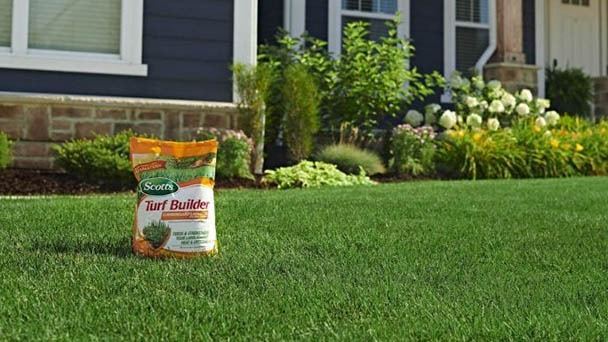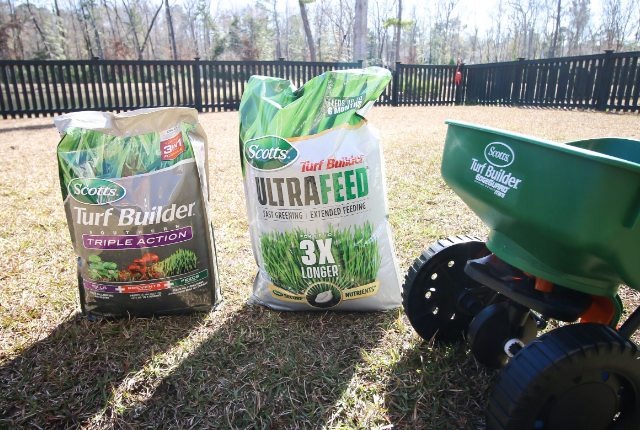When to Apply Scotts Turf Builder & How to Use
Written by Ivy
Dec 29 2022

When the temperature is between 65 and 90 degrees, Turf Builder performs at its best. It should be applied in the spring through the fall, once weeds have already sprouted in your lawn. Every season has a different turf builder at Scott's.
When to Apply Turf Builder
When applying Turf Builder or any other Scotts lawn product, the weather is important. To prevent the product from being blown away by the wind, wait for a calm day. When there is a chance of heavy rain, avoid applying the product because the water will wash the granules away. On the other hand, after it has rained, you can apply Turf Builder to a wet lawn. Generally speaking, a temperature range of 65 to 90 degrees Fahrenheit is ideal for spreading Turf Builder.
How to Apply Scotts Turf Builder

Step 1: Prepare the Spreader
For the proper amount of fertilizer to be applied to your lawn, you must adjust the spreader's setting. To find the correct setting for your particular spreader model, refer to the instructions on the bag of Turf Builder. Turn the orange dial on a Scotts Turf Builder spreader to the position listed on the package to set it.
Step 2: Fill the Spreader
Spread Turf Builder into your spreader while wearing gloves. If there are any clumps, break them up with your hands.
Step 3: Apply Turf Builder
Wheel the spreader to a corner of your lawn while keeping the spreader's hopper closed so that no product can escape. Open the hopper and mow the spreader as you move it across the lawn. With each turn, align the spreader's wheels with the wheel track you made on the last pass to guarantee that you don't have any gaps in coverage. Every time you need to move the spreader across a driveway or another non-grass area, close the hopper.
Step 4: Spray the Lawn
Apply water to the lawn using a watering can or garden hose. Although watering the lawn after applying many Scotts Turf Builder products is not strictly necessary, it is advised for the best results.
Step 5: Clean the Area
Repackage any Turf Builder that is still in your spreader in its original container. Sweep any product off your driveway or walkways by walking around the perimeter of your property. Before entering your home, brush off your shoes or wash the bottoms to get rid of any leftover Turf Builder.
How Often to Apply Scotts Turf Builder Triple Action
Applying Scotts Turf Builder Triple Action to your lawn more than twice per year is not recommended.
Between applications of this product, make sure to wait at least 2 months.
Potential Problems Using Scotts Turf Builder Triple Action
Applying Scotts Turf Builder Triple Action to your lawn has the potential to cause issues, as you should be aware of.
Lawns made of Bermudagrass, Bahiagrass, Centipedegrass, and Zoysiagrass may briefly turn discolored under specific circumstances.
Because it is not intended for those grasses, do not use it on St. Augustinegrass (including Floratam), Dichondra, Lippa, Carpetgrass, or Bentgrass.
Avoid letting product enter or runoff into gutters, sewers, or drainage ditches in order to protect the environment.
Remember that new weeds will appear white after treatment as well.
Will Scott's Turf Builder Kill Bermuda?
Scotts offers several types of Turf Builder fertilizer, and not all work with every type of grass. Use of products like Scotts Turf Builder with Weed-and-Feed, for instance, is not advised on St. Grows in USDA zones 8 through 10 is augustine grass (Stenotaphrum secundatum). The Turf Builder products can all be used safely on a lawn that is covered in Bermuda grass.
About Scotts Turf Builder Triple Action
Three advantages are offered by one bag of Scotts Turf Builder Triple Action.
This 3-in-1 formula strengthens and feeds your lawn while also killing and preventing weeds.
It prevents crabgrass for up to 4 months and eliminates broadleaf weeds like dandelions and clover.
Additionally, it inhibits the growth of other grassy weeds on the list, such as foxtail, annual bluegrass, fall panicum, and barnyardgrass.
Bermudagrass, Bahiagrass, Centipedegrass, Zoysiagrass, Tall Fescue, Fine Fescue, and Kentucky Bluegrass are among the grasses that can be treated with Scotts Turf Builder Triple Action.
Final Word
As you can see, you need to wait 4 months before planting seeds after giving your lawn Scotts Triple Action.
After the fourth mowing, you should wait to apply to freshly seeded or sodded areas.
To use the product on freshly sprayed areas, wait five months.
FAQs
When to Apply Scotts Turf Builder Early Spring
Apply when lawn is dry and before temperatures are regularly in the 80s. Use a Scotts spreader for the best results.
When to Apply Scotts Turf Builder Triple Action
Apply when daytime temperatures are consistently between 60 and 80 degrees F. Apply prior to the third or fourth mow. When dandelions start to bloom in the spring, use a product. Don't use when it's windy.Latest Updated
- Benefits of Bugleweed - 7 Science-backed Health Benefits
- Bugleweed Dangers & Side Effects - Is It Poisonous?
- How to Plant Evergreen Trees - What You Should Know
- When to Plant Evergreens - Grow Guide for Evergreen Trees
- 12 Wonderful Evergreen Shrubs for Your Garden
- 12 Popular Evergreen Plants with Pictures for Beginners
- When And How To Prune A Lilac Bush Like a Pro
- How to Grow & Care for Lilac Vine (Hardenbergia Violacea)
- Japanese Lilac Tree (Syringa Reticulata) Care & Propagation Guide
- Shumard Oak Pros and Cons - What to Know
Popular Articles
- Winter maintenance of Antirrhinum Majus
- How to Grow Terminalia Mantaly Tree
- How to Grow and Care for Crossostephium Chinense
- How to grow Antirrhinum Majus in spring
- Peristeria Elata (Dove Orchid) Profile: Info & Care Guide
- Underwatered Snake Plant (Sansevieria Trifasciata) - Signs And How To Fix
- How to Care for Brazilian Jasmine Plant (Mandevilla Sanderi)
- How to Grow & Care for Graptopetalum Purple Delight in Summer
- Rosa Chinensis (China Rose): Plant Growing & Care Tips
- How to Care for Baby Sun Rose (Aptenia Cordifolia)